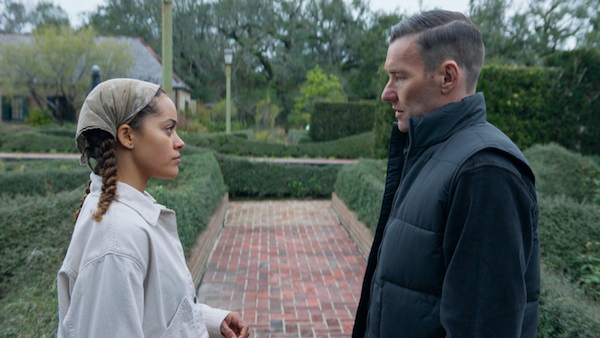Movie review by Greg Carlson
Many films have used the unsettling revelation of tattoos as a device to startle the viewer with a visual roadmap to a deeper understanding of character. The “love” and “hate” lettering across the knuckles of Robert Mitchum’s Reverend Harry Powell in “The Night of the Hunter,” in the context of the character’s chilling speech, still inspires nightmares. In “Cape Fear,” Mitchum’s Lieutenant Elgart quips of Robert De Niro’s Max Cady (a villain Mitchum originated on screen in 1962), “I don’t know whether to look at him or read him.” The prison tattoos on the body of Viggo Mortensen’s mysterious Nikolai Luzhin in “Eastern Promises” communicate a detailed history. Francis Dolarhyde’s Blake-inspired dragon, Lisbeth Salander’s own complex ink, and the grim reminders guiding Guy Pearce’s Leonard Shelby are just a few more that come to mind.
But hate tattoos of Nazism and white power reside in their own category of cinematic shock. In “Romper Stomper,” “American History X,” “The Believer,” “Skin,” and others, the display of swastikas, iron crosses, death’s heads, and other Third Reich-related runes, black suns and Parteiadler shock and stun as symbols of evil pasts and harbingers of potentially bad things yet to come. Paul Schrader draws from the trope in “Master Gardener,” the final installment of his loose, so-called “Man in a Room” trilogy that began with “First Reformed” in 2017. Second entry “The Card Counter” followed in 2021. All three movies are indebted to Schrader’s commitment to slow cinema as originally outlined in his 1972 book, “Transcendental Style in Film: Ozu, Bresson, Dreyer.”
Like the first two segments – and so many of Schrader’s previous movies – the filmmaker’s obsession with exploring tendencies toward self-destruction alongside the seemingly incongruous accompaniment of redemption links his filmography to the careers of the cinematic heroes he wrote about. In “Master Gardener,” Joel Edgerton takes on the occupation of the title as Narvel Roth, a devoted horticulturist who oversees the foliage of Gracewood Gardens, the grounds belonging to the wealthy Norma Haverhill (Sigourney Weaver). Norma, who we come to learn knows a great deal about Narvel’s past, informs him that her troubled grandniece Maya Core (Quintessa Swindell) will be joining the staff as Narvel’s apprentice.
The arrival of Maya introduces a triangle that will initiate some measure of return to the kinds of antisocial behavior Narvel practiced before he made the changes that led him to Gracewood. True to form, Schrader opts for the austerity and narrative asceticism he so admires. Those choices will delight some viewers as surely as they will alienate and frustrate others. In his curious essay on the film, Richard Brody crafts an argument that “Master Gardener” is “altogether different” from the preceding movies in the trilogy, positing that Schrader’s decision to hold at arm’s length the “matters of history and of race, of mentorship and of gardening” are deficiently ornamental and instrumental.
While I agree with Brody’s characterization of “Master Gardener” as an erotic thriller (even if that assessment is too limiting and narrow), I don’t go along with the assessment claiming a weak and tenuous link between Narvel’s redemption and the minimal effort of “a change of heart, good works, and a sense of self-punishing submission to the terms and conditions of one’s new life.” Instead, Schrader’s wicked caginess and determined reticence carves out the necessary room for us to use our own imaginations when it comes to making sense of these peculiar people.
